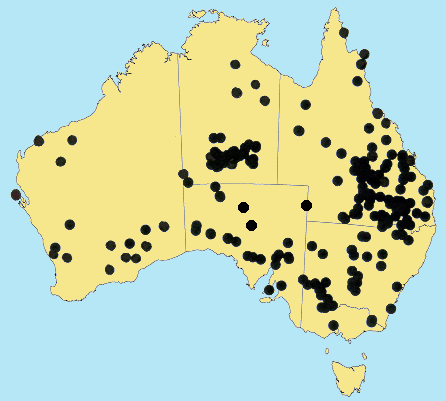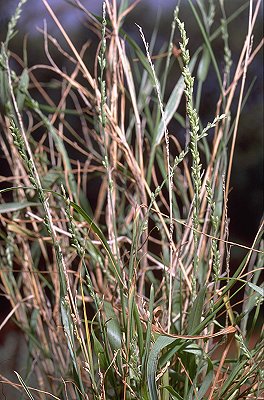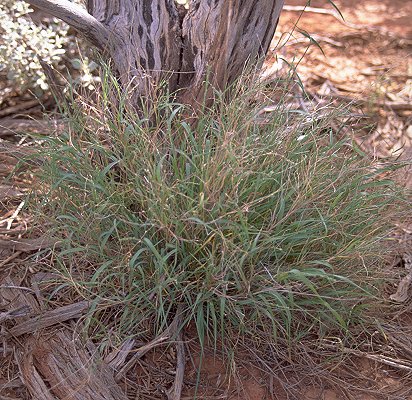Paspalidium constrictum (Domin) C.E.Hubb.
Bull. Misc. Inform. 447 (1934).
Classification. (GPWG 2001) : Subfamily
Panicoideae. Paniceae.
Basionym and/or
Replacement Name: Panicum
constrictum Domin, Biblioth. Bot. 85: 302 (1915).
Type of Basionym or
Protologue Information: Queensland: Savannenwalder bei Pentland, Domin
II 1910.
Recent synonyms:
P. gracile var. rugosum.
Key references
(books and floras): [1981] M.Lazarides in J.Jessop (ed)., Flora of
Central Australia (478), [2002] D.Sharp & B.K.Simon, AusGrass,
Grasses of Australia, [2006] J.Jessop, G.R.M.Dashorst, F.M.James, Grasses
of South Australia (478 as Setaria), [2008] S.W.L.Jacobs,
R.D.B.Walley & D.J.B.Wheeler, Grasses of New South Wales (323).
Illustrations:
[2006] J.Jessop, G.R.M.Dashorst, F.M.James, Grasses of South Australia (479, fig. 411 & plate 17 as Setaria),
[2008] S.W.L.Jacobs, R.D.B.Whalley & D.J.B.Wheeler, Grasses of New South
Wales, 4th edn (323).
Habit.
Perennial. Rhizomes absent or present. Culms erect or decumbent, 10–60 cm tall,
4–7 -noded. Mid-culm internodes solid or spongy, pubescent. Mid-culm nodes
pubescent. Lateral branches sparsely branched or branched. Leaf-sheaths
antrorsely scabrous, glabrous on surface or hairy. Ligule a fringed membrane or
a fringe of hairs, 1.25 mm long. Leaf-blades 6–15 cm long, 1–4 mm wide.
Leaf-blade surface scabrous, glabrous or indumented.
Inflorescence.
Inflorescence compound, a panicle of racemes. Racemes 5–10, appressed, 0.45–3
cm long, 1.5–3 mm wide, bearing 5–12 fertile spikelets on each. Central inflorescence
axis 6–15 cm long.
Spikelets.
Spikelets pedicelled. Fertile spikelets 2-flowered, the lower floret barren
(rarely male), the upper fertile, comprising 1 basal sterile florets,
comprising 1 fertile floret(s), without rachilla extension, elliptic, dorsally
compressed, 2.25–3.6 mm long. Rhachilla internodes elongated between glumes,
elongated below basal sterile floret, and elongated below proximal fertile
floret.
Glumes.
Glumes thinner than fertile lemma. Lower glume oblate, membranous, without keels,
(3–)5 -nerved. Lower glume surface glabrous or indumented. Lower glume apex
muticous. Upper glume orbicular, 2.1–2.9 mm long, membranous, without keels,
7–9 -nerved. Florets. Basal sterile florets 1, barren, without
significant palea. Lemma of lower sterile floret 100 % of length of spikelet,
membranous, 5 -nerved.
Fertile lemma 2.25–3.5
mm long, without keel. Lemma apex muticous.
Continental
Distribution: Australasia.
Australian
Distribution: Western Australia, Northern Territory, South Australia, Queensland,
New South Wales, Victoria.
Western Australia:
Helms. Northern Territory: Central Australia North, Central Australia
South. South Australia: North-western, Lake Eyre, Nullabor,
Gairdner-Torrens Basin, Flinders Ranges, Eastern, Eyre Peninsula, Northern
Lofty, Murray, Yorke Peninsula, Southern Lofty. Queensland: Burke,
Darling Downs, Gregory North, Leichhardt, Maranoa, Mitchell, North Kennedy,
Port Curtis, South Kennedy, Warrego, Wide Bay, Cook. New South Wales:
Northern Tablelands, North-Western Slopes, Central-Western Slopes,
North-Western Plains, South-Western Plains, North Far Western Plains. Victoria:
East Gippsland, Murray Mallee, Riverina, Volcanic Plain.
Notes.
Paspalidium constrictum is closely related to and often confused with P.
gracile. Further studies may show that the two are conspecific.
In semi-arid shrub
woodlands, shrub steppe shrublands, acacia shrublands, eucalypt shrublands,
arid tussock grasslands, and arid hummock grasslands. Flowers mostly Apr.-Aug.






